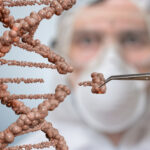Scientists alarmed by UK authorization of CRISPR gene therapy in humans
 (NaturalHealth365) CRISPR gene editing has had the scientific and medical community abuzz for years. By using bacterial genetic pieces, scientists can go in and alter cells in a way that could potentially rewrite or supposedly “cure” disease.
(NaturalHealth365) CRISPR gene editing has had the scientific and medical community abuzz for years. By using bacterial genetic pieces, scientists can go in and alter cells in a way that could potentially rewrite or supposedly “cure” disease.
Though genetic editing has come a long way, particularly in the last few years, the concept of editing our DNA is woefully under-researched. With the recent authorization of DNA alteration for sickle cell anemia and thalassemia, the question of safety regarding gene editing is again at the forefront of discussion.
We will look at just what CRISPR genetic editing procedures do in this particular case and the alarm bells that are being sounded in relation to this authorization.
CRISPR gene therapy in humans: Is it a good idea?
Sickle cell anemia and thalassemia are both diseases of the blood that cause widespread suffering, particularly among children. CRISPR editing essentially goes in and snips DNA on specific genes, turning them off or on.
In the case of these two blood diseases, editing, specifically the gene BCL11A, turns on the production of fetal hemoglobin. Another genetic tweak stops the production of adult hemoglobin, which is damaged in sickle cell and thalassemia patients. This allows for the production of necessary blood cells unaffected by the abovementioned diseases.
On the surface, this sounds like a wonderful solution, and if it were 100% reliable, it would be incredible.
Unfortunately, the research and the processes are not 100% reliable.
CRISPR genetic editing safety called into question
One of the primary issues with changing genetic structure is that you are essentially damaging the genes. While in many cases, they may behave as we anticipate, there is another potential outcome for genetically damaged cells: cancer!
If gene editing does not go as planned, it is possible that the damaged cells could turn cancerous. And while CRISPR is used in cancer treatments and is allegedly lifesaving, in the case of sickle cell and thalassemia, it has the potential to create cancer.
There is also scientific record of treatments where larger swaths of DNA were damaged, leading to other problems.
While the study followed 29 of 45 total participants for 16 months, there was no long-term follow-up. The 29 participants did not require blood transfusions for a year following the genetic editing; normally, they would have one every three to five weeks. While this outcome is wonderful, the fact that there is no long-term study does raise questions and concerns.
Is genetic editing safe?
CRISPR technology, hailed for its potential solutions spanning climate change to genetic diseases like cancer, remains in its early stages, harboring significant inherent risks. The manipulation of animal and plant genes is not exempt from dangers, and the recently approved genetic interventions for sickle cell and thalassemia patients raise serious concerns.
Not only is the prevalence of the known risks unquantifiable currently, but we still do not know what other long-term risks there are to inadvertent genetic damage or even intended genetic editing.
Sickle cell and thalassemia are terrible diseases, but it is worth noting that they can be treated with current technology. In the future, CRISPR editing may be life-changing for the better for all of humanity, but for right now, it is something to be taken with a massive grain of salt.
Sources for this article include:



